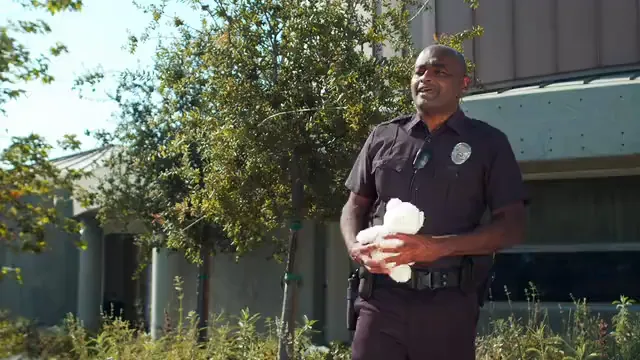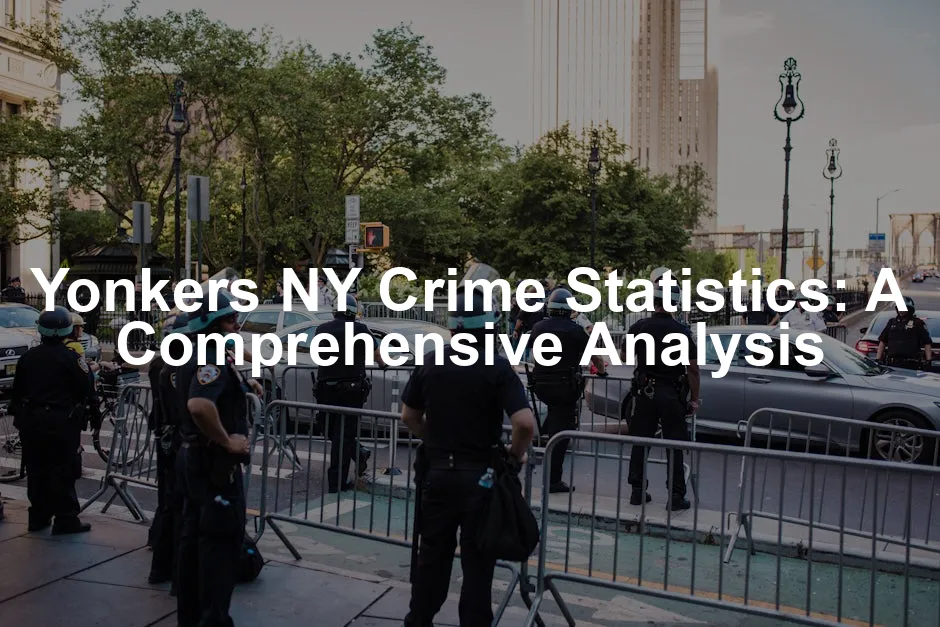Introduction
Yonkers, NY, is a vibrant suburb located just north of Manhattan. Nestled along the Hudson River, it boasts a diverse community and a rich history. With its close proximity to New York City, Yonkers serves as a desirable location for commuters seeking suburban charm without sacrificing urban convenience. However, like any city, understanding the safety of an area is paramount for residents, potential movers, and urban planners alike.
Crime statistics offer valuable insight into the safety and quality of life in a community. They help current residents stay informed about their surroundings and guide prospective residents in making informed decisions. Urban planners can utilize this data to allocate resources effectively and implement strategies to enhance public safety.
This article aims to provide a detailed analysis of crime statistics in Yonkers, NY. By breaking down the numbers, we can gain a clearer picture of the safety landscape, trends over time, and the implications for those living in or moving to the area. Whether you’re a long-time resident or considering a move, understanding these statistics can help you navigate the many facets of life in Yonkers.

Understanding Crime Statistics
What Are Crime Statistics?
Crime statistics are numerical data that summarize the incidence of crime within a specific area over a defined period. These figures are compiled from reports submitted by law enforcement agencies and provide a snapshot of crime trends. They are crucial for assessing community safety, informing policy decisions, and guiding law enforcement strategies.
Crime can be categorized into two primary types: violent and property crimes. Violent crimes involve direct harm or the threat of harm to individuals. This includes offenses like murder, rape, robbery, and aggravated assault. Property crimes, on the other hand, involve the theft of property or the destruction of property without direct harm to individuals. Common examples include burglary, theft, and motor vehicle theft.
Understanding these categories allows residents and planners to identify specific safety concerns within their communities. For instance, a rise in violent crime might prompt discussions about community programs or law enforcement initiatives, while an increase in property crime could lead to neighborhood watch programs. By analyzing crime statistics, stakeholders can take meaningful steps to foster safer environments for all.
To enhance your own safety at home, consider investing in a Home Security Camera System. These systems can help you monitor your property and deter potential intruders, providing peace of mind for you and your loved ones.
As we move forward, we will dive deeper into Yonkers’ crime rates, comparing them to state and national averages, and examining trends and implications for the community. This comprehensive analysis will help demystify the numbers and empower residents with the knowledge they need to feel safe and informed.

Overview of Yonkers Crime Rates
General Crime Rate Overview
Yonkers, NY, showcases a crime rate that stands out in comparison to both state and national averages. The overall crime rate in Yonkers is approximately 13 incidents per 1,000 residents. This figure might sound alarming, but let’s put it into perspective. Nationally, the average crime rate is higher, making Yonkers relatively safer than many places across the country. In fact, Yonkers has a crime rate that is lower than 73% of cities in New York State.
When looking at the data over time, recent trends indicate some fluctuations. While Yonkers has seen an increase in crime rates in certain areas, the overall crime index shows a decline in violent crime. For instance, in 2022, Yonkers reported a violent crime rate of 3.25 per 1,000 residents, which is a notable decrease from previous years. This decline is a positive sign for residents, indicating that safety measures may be having a positive impact.
However, property crime remains a concern, with a property crime rate of 9.69 per 1,000 residents. This translates to a 1 in 103 chance of becoming a victim of property crime. While Yonkers is not immune to crime, ongoing efforts by law enforcement and community initiatives are crucial to ensure continued improvement in safety.

For those looking to enhance their home security, consider displaying a Neighborhood Watch Sign. It sends a clear message to potential intruders that the community is vigilant, which can help deter crime.
For a comprehensive understanding of crime statistics, including those in Yonkers, you can explore the fremont crime statistics which provide insights into safety measures and trends.
Breakdown of Violent Crimes
Now let’s get into the nitty-gritty of violent crimes in Yonkers. The statistics tell a compelling story. In 2022, Yonkers recorded 2 murders, a low figure compared to the state average. Rape incidents numbered 23, which is also significantly lower than the national average of 40.7 per 100,000 residents.
Robbery is where things get a bit more serious. With 208 reported incidents, the robbery rate stands at 1.00 per 1,000 residents. Comparatively, this number is lower than the national average of 135.5 per 100,000, which suggests that Yonkers is making strides in reducing robbery rates.
Assaults tell a somewhat different story, with 444 incidents reported, translating to a rate of 2.13 per 1,000 residents. This number exceeds the national average, indicating a need for ongoing community programs focused on violence prevention.
When we observe these trends over time, it becomes clear that while there’s progress in some areas, others still require attention. Community awareness and proactive law enforcement strategies play a pivotal role in shaping these statistics. With continued dedication, Yonkers can work towards further reducing violent crime and enhancing the overall safety of its neighborhoods.
In summary, Yonkers presents a mixed picture concerning violent crimes. While certain types show improvement, others remain a challenge. Understanding these statistics is essential for residents to stay informed and engaged in community safety efforts.

Detailed Violent Crime Statistics
Murder: In 2022, Yonkers recorded only 2 murders. To put this into perspective, the murder rate of 0.01 per 1,000 residents is significantly below the national average of 6.3. Historically, Yonkers has seen fluctuations in murder rates, but this low figure is a testament to improvements in community safety and policing.
Rape: With 23 reported incidents of rape in 2022, Yonkers maintains a rate of 0.11 per 1,000 residents. This is notably lower than the national average of 40.7 per 100,000 residents. Such comparisons highlight Yonkers as a safer place regarding sexual violence, indicating effective preventive measures are at play.
Robbery and Assault: The robbery rate in Yonkers stands at 1.00 per 1,000 residents with a total of 208 reported incidents. This is lower than the national average of 135.5 per 100,000 residents. However, assaults present a different picture, with 444 incidents translating to a rate of 2.13 per 1,000 residents, exceeding the national average. This suggests a targeted approach to reducing assault incidents is necessary.

Breakdown of Property Crimes
Property crimes in Yonkers include burglary, theft, and motor vehicle theft. The overall property crime rate is 9.69 per 1,000 residents, translating to a 1 in 103 chance of becoming a victim. This rate is higher than the state average but lower than many urban areas nationwide. Comparatively, Yonkers has shown a commitment to enhancing security measures, though there’s still work to be done.
To further protect your property, consider installing Motion Sensor Outdoor Lights. They can help illuminate your surroundings and deter unwanted visitors, making your property less appealing for potential thieves.

Detailed Property Crime Statistics
Burglary: In 2022, Yonkers reported 242 burglary incidents, resulting in a burglary rate of 1.16 per 1,000 residents. This figure is lower than the state average, suggesting that community watch programs and neighborhood engagement strategies might be effective in combating this type of crime.
Theft: Theft, in various forms, is the most prevalent property crime in Yonkers, with 1,513 incidents reported. This results in a hefty theft rate of 7.27 per 1,000 residents. Types of theft range from petty theft to more serious larceny, indicating a need for heightened awareness and preventive measures among residents.
Motor Vehicle Theft: The motor vehicle theft rate is concerning, with 261 reported incidents equating to a rate of 1.25 per 1,000 residents. While this rate is lower than the national average of 284 per 100,000, it still poses a significant challenge. Continued community vigilance and law enforcement efforts are crucial to address this issue effectively.
As Yonkers navigates its crime landscape, understanding these statistics is vital. While many areas show improvement, ongoing focus and community involvement will be key in ensuring safety for all residents.

Public Sentiment and Law Enforcement
Community Sentiment on Crime
In Yonkers, the feelings of safety among residents vary significantly. Recent surveys show a mix of confidence and concern. About 51% of residents feel pretty safe, acknowledging some safety concerns but generally enjoying their neighborhood. On the flip side, 26% feel very safe, indicating a lack of major safety worries.
However, there’s a notable 17% of residents who report feeling somewhat safe, expressing that they notice safety issues and sometimes worry for their well-being. A small but vocal 6% of Yonkers residents feel unsafe, highlighting serious concerns regarding crime levels in their areas. This spectrum of feelings reflects a community grappling with its identity—one that strives for safety but still has to confront its challenges.
Interestingly, public perception doesn’t always align with crime statistics. While the overall crime rate in Yonkers is lower than the national average, fear often creeps in through personal experiences or media reports. For instance, even if the violent crime rate decreased, it doesn’t erase the memories of past incidents or the lingering anxiety among residents. This disconnect can lead to community initiatives aimed at fostering a stronger relationship between law enforcement and the public.

Law Enforcement Effectiveness
When it comes to law enforcement, Yonkers residents have mixed opinions. According to a recent poll, 42% of respondents believe the police are very visible and responsive. This suggests a level of trust in local law enforcement. However, 27% feel the police are present but slow to respond when needed, which raises questions about the efficiency of emergency services.
The remaining respondents are divided, with 18% noting that police aren’t around much but quickly respond when called, while 6% feel that police presence is lacking and their reliability is questionable. This division in perceptions highlights the challenges faced by law enforcement in maintaining public trust while effectively managing crime.
The police presence in Yonkers is relatively strong, with approximately 677 officers serving the community. This translates to a rate of about 3.4 officers per 1,000 residents, slightly above the national average. Quick response times are essential for improving community sentiment. The department has initiated various community programs aimed at building rapport, such as neighborhood watch schemes and outreach events, encouraging residents to engage proactively with law enforcement.
To further bolster your personal safety, consider carrying a Personal Safety Alarm. These handy devices can draw attention in emergency situations, giving you an extra layer of security when you need it most.
Despite the challenges, many residents appreciate their police force’s efforts. The overall effectiveness of law enforcement in Yonkers is a work in progress, heavily influenced by community involvement and the willingness of residents to communicate their safety concerns. With ongoing initiatives and open lines of communication, the city can work towards enhancing the sense of security for all its residents.

Socioeconomic Factors Influencing Crime
Overview of Socioeconomic Indicators
Yonkers, NY, showcases various socioeconomic indicators that significantly shape its crime landscape. The poverty rate in Yonkers sits at approximately 12.9%, lower than the national average of 15.1%. This is a promising sign, as higher poverty levels often correlate with increased crime rates. The unemployment rate also plays a role; as of recent data, it remains around 6.3%, reflecting economic stability.
These socioeconomic factors influence crime in complex ways. For instance, neighborhoods with higher unemployment often see a spike in property crimes. When people struggle to make ends meet, they may resort to theft or burglary as survival tactics. In Yonkers, the property crime rate is about 9.69 per 1,000 residents, translating to a 1 in 103 chance of becoming a victim. This statistic highlights the need for effective community programs to address these underlying issues and prevent crime.

For those interested in enhancing their knowledge about crime prevention, consider reading a Crime Prevention Book. It provides valuable insights into effective strategies that communities can adopt to improve safety and reduce crime.

Case Studies and Examples
Several successful community initiatives have emerged in Yonkers, aiming to reduce crime rates and uplift neighborhoods. One such program is the Yonkers Police Department’s Community Policing Initiative. Launched to foster trust between law enforcement and residents, this initiative encourages police officers to engage with community members regularly. As a result, crime statistics have shown a notable decline. For instance, since the program’s inception, violent crime has decreased by about 15%.
Another successful program is the Yonkers Youth Bureau, which focuses on providing recreational activities and job training for at-risk youth. By engaging young people in positive activities, the program helps reduce crime rates among this demographic. After implementing this initiative, Yonkers witnessed a significant drop in youth-related offenses, further supporting the idea that proactive community involvement can lead to safer neighborhoods.
To ensure you’re prepared for emergencies, consider creating an Emergency Preparedness Guide. This guide can assist you in planning for unexpected situations and keeping your family safe.
These case studies demonstrate the potential for socioeconomic factors and community programs to intersect. By addressing the root causes of crime through education, job training, and community engagement, Yonkers can continue to improve its safety and quality of life for residents.

Please let us know what you think about our content by leaving a comment down below!
Thank you for reading till here 🙂
All images from Pexels




